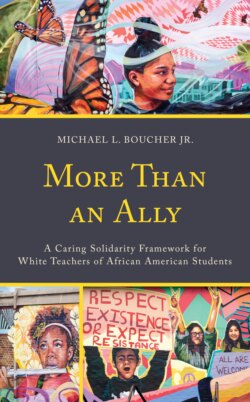Читать книгу More Than an Ally - Michael L. Boucher Jr. - Страница 7
На сайте Литреса книга снята с продажи.
Strategic Essentialism and Diversity
ОглавлениеThe focus of this work is the teaching of African American students by White teachers. These categories are imposed in order to begin a dialogue, but there is no assumption that these categories are static or isolated from the history of colonization, slavery, segregation, and White supremacy. However, unless artificial categories are overlaid to some extent, the discussion becomes so watered down as to become meaningless. This specific type of essentialism allows for a conversation about race.
According to Azoulay (1997), strategic essentialism is a “prerequisite for dialogue” about race (p. 102). Strategic essentialism opens up the intellectual space by grouping people together, even in ways that do not always reflect people’s lived reality. To understand that race is a socially constructed concept should not get in the way of understanding that it is also a historical reality. To deny this leads people to the kind of color-blind ideology that only reifies the current social and political structure of White privilege and “color-blind racism” (Bonilla-Silva, 2010, p. 40).
Strategic essentialism should not be confused with essentialized frameworks like White supremacy, which assumes that White people are fundamentally better and more equipped to run things than people of color. White supremacy essentializes others who are not assumed to be White and places them in the category of diverse or non-White, while White people are considered normal and outside of race (Irving, 2014). All over the world, White people have created spaces for themselves and pushed others to the margins. However, in each context blackness and the response to it are different. The binary of Black and White does not work in all global contexts and does not even scratch the surface of the range of human diversity.
A caveat is important here. Strategic essentialism is a device meant to be used temporarily to give space for discussion of real historical issues. Thus, when talking about Black and White people, the tool of essentialized racial categories allows for the discussion of race in the United States and in the study of diverse classrooms. If strategic essentialism is never abandoned, the danger is that it will become real essentialism and move away from its original intent.
With that danger in mind, it is important for teachers and researchers to acknowledge that while some group identifications are real, and while historical inequity and racism are real, the racialized concepts that ground these notions are socially constructed and are not based on any biologically determinable differences (Helfenbein, 2003).
